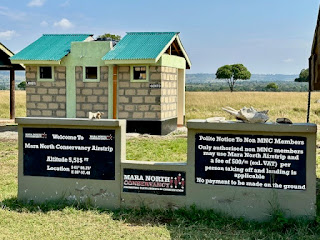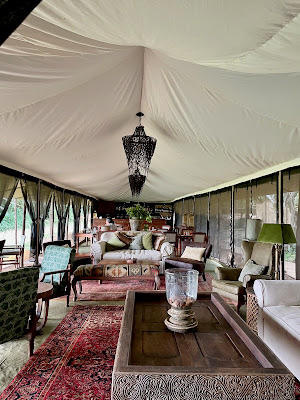Mara North Conservancy and Masai Mara National Reserve
Our final Kenya stop was at Elewana Elephant Pepper Camp, located in Mara North Conservancy. The
conservancy was established in 2009. It consists of 70,000 acres and borders the even larger 128,000 acre Masai Mara National Reserve. The conservancy has many species, including Cape buffalo, zebras, hippo, crocodiles, giraffe, elephant, lion, leopard, cheetah, elands, hyenas, topi and warthogs. The geography ranges from shallow sandy areas, tropical savannah, to deep silt areas with poor drainage. This location allowed us to devote one full day (6am -6pm) visiting the Masai Mara National Reserve - and a chance to view the massive wildebeest and zebra migration through the Mara River.
conservancy was established in 2009. It consists of 70,000 acres and borders the even larger 128,000 acre Masai Mara National Reserve. The conservancy has many species, including Cape buffalo, zebras, hippo, crocodiles, giraffe, elephant, lion, leopard, cheetah, elands, hyenas, topi and warthogs. The geography ranges from shallow sandy areas, tropical savannah, to deep silt areas with poor drainage. This location allowed us to devote one full day (6am -6pm) visiting the Masai Mara National Reserve - and a chance to view the massive wildebeest and zebra migration through the Mara River.
We stayed at this location for four nights, which was our longest stay in a single Kenya bush camp.
Elewana Elephant Pepper Camp
This camp consisted of ten bush tents, two of which were larger suite tents. The relatively small number of tents translated into about 20-24 guests at any one time.
The tents were nicely furnished with king bedding (or twins), electricity, purified water containers, WIFI, dual bathroom sinks, shower and toilet. Tap water was not used for teeth brushing. The tent was not as luxurious as our Sirikoi tent and seemed to reflect an older time bush tent vibe (though with running hot and cold water). There were no electric fences, so an escort was needed when walking in the camp during the dark early hours or after dinner. Our tent was a bit weathered near the front zipper entry area but was otherwise well-maintained. During several hours of rain on one evening, the tent remained dry and comfortable.
Meals were served in the large common tent, with separate tables for each safari guest group. In-camp breakfasts were ala carte. Lunch included five to six small servings to be shared at our table for two. Dinners were from a menu selection. The meals were delicious and varied. We particularly enjoyed the lunches and the creative offerings available for this meal. There were also opportunities for both a post-game drive bush breakfast and a bush lunch if you choose an all-day activity.
I walked around camp and briefly viewed the kitchen area, vegetable and fruit gardens, solar array and batteries, vehicle maintenance area and produce and food storage container.
This camp, similar to the others, was based on full board. This included all meals, drinks, game drives and bush walk option. After viewing from a safari vehicle for many Kenya game drives, we decided to spend one morning on a bush walk. This approximately 2 mile walk allowed us to view animal tracks and local plants and flowers with descriptions of traditional Masai use. We were accompanied on this walk by a guide and two Masai guards with spears. The walk was one way and we all returned to camp for breakfast via a safari vehicle. Note we did have to sign a responsibility waiver prior to the start of the bush walk.
 |
| Elewana Collection |
 |
| The Bathroom Area is Behind the Drapes Elewana Collection |
 |
| Delicious Lunch Selections |
 |
| Another Lunch at Elephant Pepper Camp |
We were able to participate in four game drives and one bush walk in Mara North Conservancy. One day was devoted to Masai Mara National Reserve. During our game drives, we viewed the elusive leopard and cheetah. These cats were present but not seen in Lewa Wildlife Conservancy or Amboseli.
 |
| Bush Walk Group |
Our all-day visit to Masai Mara National Reserve allowed us to see massive herds of wildebeest, buffalo and zebra. These herd sizes were not seen at the other Kenya camp locations.
In the Reserve, we devoted several hours watching smaller wildebeest herds and zebras considering whether to cross the crocodile laden Mara River. This crossing is part of the annual migration and visitors often see thousands of animals crossing the River from the Serengetti to Masai Mara National Reserve. However, the late rains and climate change delayed the annual crossings this year. Despite devoting our attention to the Mara River, smaller wildebeest herds inspected the river area and backed away, deciding to cross another day. As this was our last game drive day in Kenya, we left pleased with memories seeing the large grazing herds.
.jpeg) |
| Wildebeest Herd |
.jpeg) |
| Cape Buffalo Herd |
.jpeg) |
| Spotted Hyena |
.jpeg) |
| Wildebeest Herd |
.jpeg) |
| How Many Zebras? |
.jpeg) |
| Vultures Picking at Carcass |
.jpeg) |
| Cross the River? |
.jpeg) |
| Our Final Airflight from Mara North to Nairobi |
In Dubai, we spent five hours in the airport business lounge before starting our very long Emirates 380 15 hour nonstop flight from Dubai to San Francisco. Although this was a long set of flights, we found the pricing of these tickets very competitive.
Overall, this was a wonderful trip. Fish Eagle Safaris and Origins Safari put together both a great itinerary and a set of three bush camps - each a bit different than the other. While traveling as a couple in Africa, rather than in a group, we were always in great care by Kenyan staff.
Latest Update
It was shared with me that Elewana Elephant Pepper Camp will receive a substantial upgrade in November 2024. The existing ten guest tents will be replaced with new tents and five more guest tents will be added to the camp. The dining, reception and gift/library tents will also be replaced with larger tents. In addition, the guest bathroom near the dining and reception area will be upgraded. Quite a few changes for Elephant Pepper Camp for the 2025 season!



.jpeg)


.jpeg)
.jpeg)
.jpeg)

.jpeg)

.jpeg)

.jpeg)
.jpeg)

.jpeg)
.jpeg)
.jpeg)
.jpeg)

.jpeg)
.jpeg)
.jpeg)
.jpeg)
.jpeg)
.jpeg)
.jpeg)
.jpeg)
.jpeg)
.jpeg)


No comments:
Post a Comment